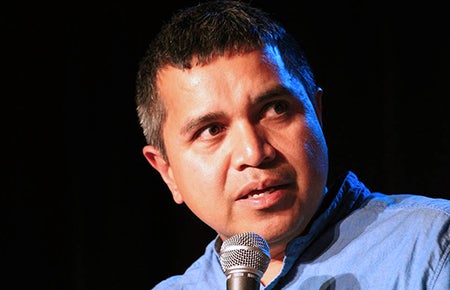
Technology: a positive force for democracy or a source of political polarization?
As widespread concerns about hacking, the spread of fake news and manipulation by foreign powers such as Russia spur lawmakers to call for stricter regulation of social media platforms, Americans are raising questions about whether technology has led to an increase in polarization and a lack of compromise in our political system.
To explore the issues involved, on Nov. 14, USC Dornsife’s Department of Political Science co-hosted a panel discussion, “Technocracy: Examining Tech’s Role in the Polarization of U.S. Politics,” with the Jesse M. Unruh Institute of Politics and USC Viterbi School of Engineering.
Taking part were alumnus Ravi Iyer, executive director of Civil Politics and chief data scientist at digital consumer opinion database and platform Ranker.com, the world’s largest crowdsourcing site; Democratic consultant Bill Carrick, who has served as a senior political strategist to California Senator Diane Feinstein and Los Angeles Mayor Eric Garcetti; and Justin Wallin, CEO and pollster at J. Wallin Opinion Research.

From left: Justin Wallin, Bill Carrick, Ravi Iyer and Krishna Nayak with Robert Shrum, director of the Unruh Institute of Politics.
“Like gasoline on the fire”
Moderator Krishna Nayak, professor of electrical engineering at USC Viterbi, kicked off the discussion by noting that although it’s only been a year since the presidential election, it seems hard to remember a time when Facebook wasn’t synonymous with fake news, false information spread on social media by everyone from the financially motivated to foreign propaganda agents.
Iyer, who earned his Ph.D. in psychology from USC Dornsife in 2011, considers fake news a symptom of the country’s polarization rather than the cause. “People believe what they want to believe and … social media is like gasoline on the fire,” he said.
Carrick argued that fake news allowed voters in the 2016 election to discount what was going on in mainstream media, no matter how poorly it reflected on their candidate. “It allowed them to assume it was coming from a biased point of view and therefore to ignore it,” Carrick said. “That’s not been typical of past American campaigns.”
Wallin noted that a similar situation is occurring in Alabama, where he said supporters of Roy Moore — who has continued to run for the Senate despite facing multiple accusations of sexual assault against minors — are trying to rationalize the situation so they can continue to vote for him. Rather than blaming their candidate, they instead blame the messenger: the mainstream news media that reported the allegations.
However, Wallin disputed whether fake news had much affected the 2016 election, arguing that the Facebook spend was too low to effect change.
To regulate or not to regulate?
Noting the shift in control of news information from media companies with editors and editorial policies to tech companies that may lack this expertise, Nayak asked whether political ads on social media should be regulated.

Alumnus Ravi Iyer, who earned a Ph.D. in psychology from USC Dornsife in 2011.
Carrick was in favor but noted that online communications are not federally regulated, raising the question of whether companies will be self-policing or whether Congress should step in.
Iyer said technology moves too fast for the government to meaningfully regulate. However, he’s optimistic that the situation will improve as we realize how unhealthy our information diet is becoming.
Wallin raised the practical difficulties of tracing the source of online ads paid for by a PAC.
“Unravelling how the funds get into that PAC is very difficult, if not impossible,” he said. “The point is that you’re not going to see a Facebook ad or any kind of ad with the disclaimer ‘This ad was purchased by the Russian Government.’”
Living in a bubble
Asked whether there will ever again be a media source that is believed by the majority of the population, Carrick said it would be difficult given today’s enormous media fragmentation.
“People are not only self-selecting about the news, they’re also self-selecting about where they get their news,” he said. “That’s a big change — people who are so ideologically driven about where they get information from.”
Wallin said today people tune into the news for entertainment rather than reasoned analysis of the issues as they used to do.
“I don’t know if we have an appetite to go back,” he said.
Carrick stressed the danger posed by Twitter and Facebook bubbles that allow people to self-identify the views they want to hear. These bubbles are then exacerbated by algorithms that provide similar ideological content.
Iyer noted that research shows we are three times more likely to click on things that are negatively rather than positively framed.
“Asked whether it would be advantageous to change algorithms, so people are exposed to messages from differing viewpoints, Waller questioned who would pay for that.
Iyer said a precedent for that kind of algorithm does exist. He noted that research shows people are less affected by information than they are by human connection, by emotion, by stories.
“If you want to affect people’s attitudes, what would you want to show them?” Iyer asked. “Probably something a little more emotional or social, rather than more rational.”
Will the current situation improve? While neither Carrick nor Iyer held out much hope for the 2018 mid-terms, both were optimistic that eventually partisan intensity will diminish.
“The hope is that there are also people who put on conversations like this, who are actually trying to not be so polarized [in order] to make things better,’” Iyer said. “Hopefully, if those efforts succeed, that’s what will solve things, not technology.”